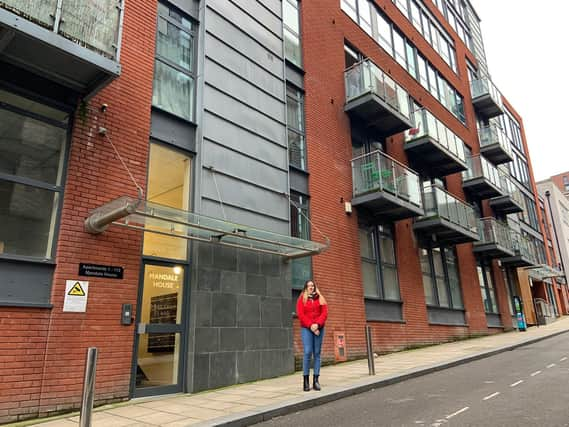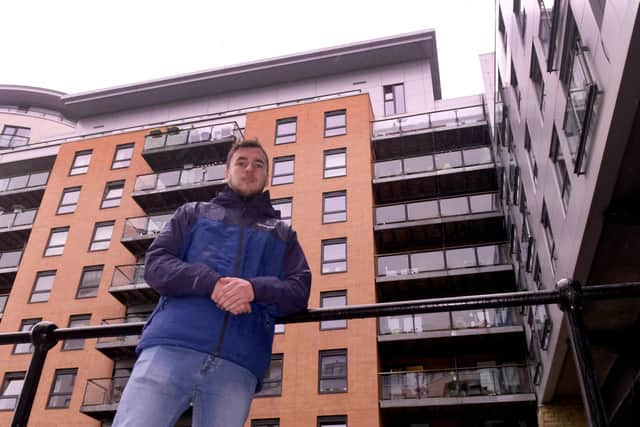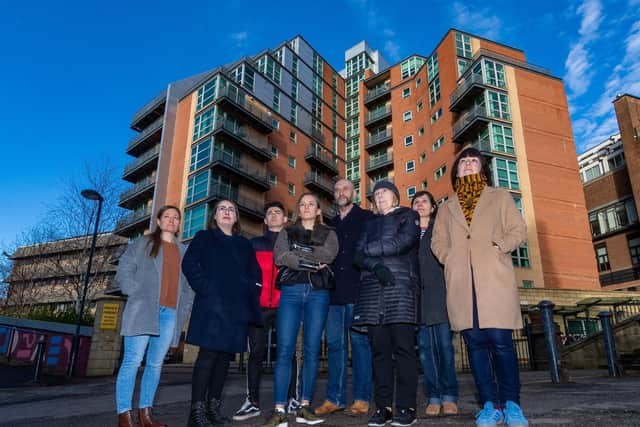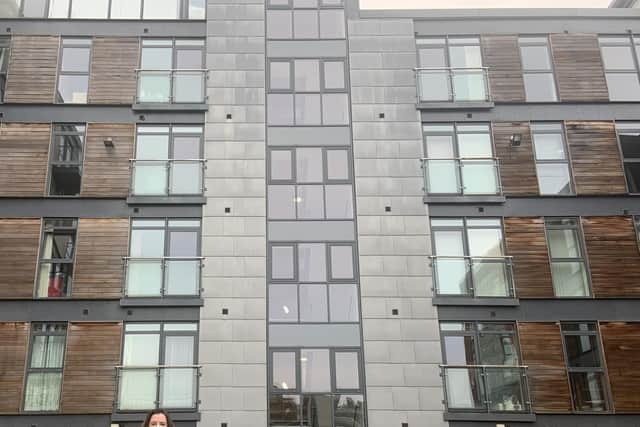These first-time buyers are caught in a terrifying trap thanks to the cladding scandal


The flammable cladding and insulation scandal came to light after the Grenfell Tower fire tragedy three-and-a-half years ago but those who own the leasehold apartments now deemed dangerous are still trapped and unable to sell their blighted properties. Some have been forced to declare themselves bankrupt and it is predicted that many more will follow as they are unable to pay the increased service charges demanded by the owners/freeholders of the blocks for extra costs such as more sophisticated fire alarms and higher buildings insurance.
While the Government has set up a £1.6bn fund to replace flammable cladding, there are fears that this will run dry and that cladding removal from all affected buildings could take years due to the lack of specialist contractors. Another major worry is the cost of fixing other fire safety issues that have been uncovered, including insufficient or flawed firebreaks and timber balconies. Many of the developers who built the blocks have gone into liquidation so the bill is being shunted onto leasehold flat owners thanks to contracts that protect the building owners and the developers.
Advertisement
Hide AdAdvertisement
Hide AdRecent Land Registry figures reveal that UK flat sales halved year-on-year in September 2020, due to the cladding issue and Yorkshire towns and cities have been affected with Leeds suffering most thanks to the city centre apartment boom in the noughties. There are at least 70 apartment buildings with unsafe cladding in Leeds. Sheffield has 36 blocks deemed unsafe and Bradford has 16.


Estate agent Jonathan Morgan says only a handful of buildings constructed post 2001 in Leeds city centre have flats that are mortgageable, though these must have an External Wall Safety certificate, which have caused chaos. Mortgage expert Andrew Milnes reveals more on the EWS1 form issue in his column below.
The latest burden on those who unwittingly bought flats in unsafe buildings is the Government’s idea of giving loans starting at £40,000 to each leasehold apartment owner to pay for remediation. They would carry the debt even though the leaseholders bear no responsibility for the original construction of the flats, deemed safe by building inspectors at the time.
While Housing Secretary Robert Jenrick and Chancellor Rishi Sunak are now said to be exploring cladding campaigners’ suggestion of a levy on the big building firms to pay for the expected £15bn repair bills on unsafe flats, misery for those trapped continues.
Advertisement
Hide AdAdvertisement
Hide AdHere, three first time buyers tell us that, despite doing everything right, their longed-for leap onto the property ladder has caused misery, anxiety, money issues and, in one tragic case, homelessness.


Down and out
Property Post documented Hayley Tillotson’s story last summer but her situation became so bad that just before Christmas she declared herself bankrupt and became homeless.
She is now back where she started, in a spare room at her father’s house, which is where she first began saving for her first home.
It took Hayley five years to scrimp and save for a deposit and she was proud and happy when she got the keys to a £101,750 one-bedroom flat in the St George building in Leeds city centre.


Advertisement
Hide AdAdvertisement
Hide AdShe lived her dream for four months before cladding and other fire safety issues rendered her home unmortgageable and impossible to sell. She and other leaseholders were forced to pay towards upgrading the fire alarm, increased insurance premiums and for a “waking watch” 24 hour fire patrol. The extra costs were unmanageable as was the continual anxiety so she had no option but to file for bankruptcy.
“I looked at letting the flat and moving to my dad’s but because I bought my leasehold flat from a housing association with a 25 per cent discount, I couldn’t as it wasn’t allowed and I also didn’t want to put anyone at risk of fire,” she says. “I am lucky my dad was kind enough to put me up otherwise I would be homeless. I spent everything I had on the flat and then I even had to pay £680 to file for bankruptcy.”
Hayley is penniless and carries the burden of bankruptcy, which means she cannot get a mortgage or any credit for at least six years and will see any earnings reduced for three years as some will be used to pay her creditors, in this case that is the mortgage lender for resale and shortfall fees and to the insolvency service for their work on her case. She says: “It’s not as simple as handing back the keys. It means that for another six years I will still be paying for someone else’s mistake and I am just as helpless and powerless.”
Despite her situation, Hayley is using her marketing skills to campaign for friends and former neighbours caught in the cladding scandal. Find her on Twitter @scantilyclad. She adds: “It has ruined my life and I’m seriously thinking that I now won’t have children but I am trying to use my anger to help get justice for my former neighbours.”
Cladding prisoner
Advertisement
Hide AdAdvertisement
Hide AdOlivia Hill, 25, is a campaigner for the recently-formed Sheffield Cladding Action Group. A PHD student, she bought her first home, a flat at Mandale House in Sheffield city centre, two years ago after saving via a Help to Buy ISA. The property was deemed unsafe in November last year due to flammable cladding, timber balconies, safety breaks and inadequate cavity barriers
The apartments are effectively unsaleable and the service charge is now £3,000 per year for a two-bedroom flat thanks to higher insurance premiums and waking watch fire patrols, which cost £10,000 per month for the 111 home building. While the management company is looking to get government funding for the waking watch, the longer term solution of an updated fire alarm system has been costed at £100,000.
“I was so excited when I got the keys to my home. I bought it because I thought it would be a safe place to live and it is now anything but. The personal loan that the Government is suggesting that we, as leaseholders, take is not fair and is a big worry. This is not our fault. The other worry is how long it will take for the work to be done as there aren’t enough specialists insured to do it. It could take years and in the meantime our flats will be effectively unsaleable. It has soured my experience of being a first-time buyer.”
Olivia now spends much of her free time fighting for justice, along with other members of the Sheffield Cladding Action Group. You can find them on Twitter and Facebook.
Hard work did not pay off
Advertisement
Hide AdAdvertisement
Hide AdBrad Cunningham, 25, is sick with worry, not just about living on the sixth floor of a building with flammable cladding but because he can’t bear the thought of being saddled with debt.
He left school at 16 with one big ambition - to buy his own home. Grafting hard and saving harder meant he was able to buy his heart’s desire, a one-bedroom flat at the fashionable Leeds Dock.
“I rented here for a year and thought it would be a better investment if I bought,” says Brad, who works for a telecoms company. He bought his leasehold apartment two years ago
thinking it would sell quickly if he wanted to move on. Instead he is trapped.
Advertisement
Hide AdAdvertisement
Hide Ad“In October last year I got a letter from the management company saying I had to pay a £600 one-off fee for a waking watch fire patrol and for an insurance hike because we had unsafe cladding. Now, we have just been told we have to pay £170 extra each month for ‘interim measures’ on top of our usual service charge of £110," he says.
While he finds that difficult, he is “frightened to death” of the Government’s proposal of saddling leaseholders with a building remediation loan. He says: “I thought I’d done everything right and that I would be enjoying life in the city. Instead I am worrying myself sick about possible debt and the risk of fire while poring over spread sheets trying to budget so I can pay for someone else’s mistake.”
*Government comment: A Ministry of Housing, Communities and Local Government spokesperson said: “Our priority is removing dangerous cladding as quickly as possible – backed by £1.6bn of funding. In addition, we have announced an extra £30m to help end the scandal of excessive waking watch costs.
“Building safety is the responsibility of building owners and they should seek the costs of remediation work from developers and their warranty schemes, without passing them on to leaseholders. We are considering options to fund future remediation.”
Advertisement
Hide AdAdvertisement
Hide AdNumber of apartments in Yorkshire blighted by unsafe cladding
The number of apartment blocks in Yorkshire known to be blighted by unsafe cladding adds up to 143. The highest concentration is in Leeds, where 70 buildings have unsafe cladding.
Sheffield has 36 blocks affected and Bradford has 16. Elsewhere, Wakefield has nine apartment buildings with unsafe cladding, Calderdale and Kirklees each have six.
*Please support The Yorkshire Post and become a subscriber today. Your subscription will help us to continue to bring quality news to the people of Yorkshire. In return, you'll see fewer ads on site, get free access to our app and receive exclusive members-only offers. Click here to subscribe
Comment Guidelines
National World encourages reader discussion on our stories. User feedback, insights and back-and-forth exchanges add a rich layer of context to reporting. Please review our Community Guidelines before commenting.